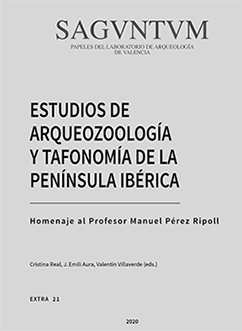Avifauna de la Cueva de Nerja (30,5-7,2 ka cal BP. Tafonomía, taxonomía, paleoclimatología y contextualización arqueológica
Palabras clave:
paleogeografía, paleoclimatología Resumen
Resumen
Cueva de Nerja has provided a diversified assemblage of birds. In this work the avian bones recovered at the Upper Palaeolithic, Mesolithic and Neolithic levels in the excavations led by F. Jordá Cerdá is analyzed. The identification of 11 orders, including 14 families and 16 taxa, allows to link their variability with the paleoclimatology and paleogeography of the site, affected by changes in the position of the coastline between 30.5 to 7.2 ka cal BP. The trends are related to the general economic changes for terrestrial and marine resources. The study of the cut-marks and fractures on different bones and species indicates that the assemblage has an anthropic origin. The results obtained provide data on the exploitation of different ecological environments and contribute to the knowledge about the use of birds during the Upper Palaeolithic, Epipalaeolithic-Mesolithic and Neolithic phases in the Iberian Mediterranean region.
 Descargas
Descargas
Descargas
Publicado
Cómo citar
-
Resumen332
-
PDF206
Número
Sección
Licencia

Este obra está bajo una licencia de Creative Commons Reconocimiento-NoComercial-SinObraDerivada 4.0 Internacional.
Con la publicación impresa de los trabajos, los/as autores/as aceptan que el Departament de Prehistòria, Arqueologia i Història Antiga de la Universitat de València pueda permitir la difusión y el libre acceso a través de las direcciones electrónicas y enlaces del editor/a.
El contenido de los trabajos es responsabilidad de los/as autores firmantes y no expresa la posición ni la opinión del Consejo de Redacción.
Las obras que se publican en esta revista están sujetas a los siguientes términos:
1. La revista conserva los derechos patrimoniales (copyright) de las obras publicadas, y favorece y permite la reutilización de las mismas bajo la licencia indicada en el punto 2.
2. Las obras se publican en la edición electrónica de la revista bajo una licencia Creative Commons Reconocimiento-NoComercial-SinObraDerivada 3.0 España (texto legal). Se pueden copiar, usar, difundir, transmitir y exponer públicamente, siempre que se cite la autoría, la url, y la revista, y no se usen para fines comerciales.
3. Los/as autores/as están de acuerdo con la licencia de uso utilizada por la revista, con las condiciones de auto-archivo y con la política de acceso abierto.
4. En caso de reutilización de las obras publicadas debe mencionarse la existencia y especificaciones de la licencia de uso además de mencionar la autoría y fuente original de su publicación.



